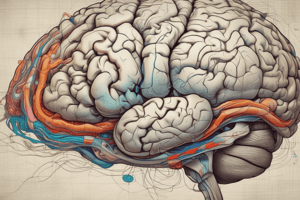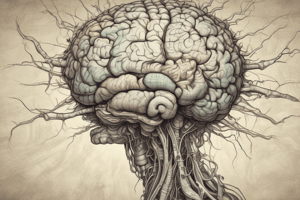Podcast
Questions and Answers
What was the primary objective of the Lebedev et al. (2004) study?
What was the primary objective of the Lebedev et al. (2004) study?
- Exploring the impact of visual stimuli on cognitive processes in monkeys
- Investigating neural mechanisms underlying the representation of attended and remembered locations in the prefrontal cortex (PFC) of monkeys (correct)
- Studying the motor functions of monkeys during saccadic eye movements
- Analyzing the auditory processing in the prefrontal cortex (PFC) of monkeys
Why was the dorsolateral prefrontal cortex (PFdl) selected for investigation in the Lebedev et al. (2004) study?
Why was the dorsolateral prefrontal cortex (PFdl) selected for investigation in the Lebedev et al. (2004) study?
- It has been implicated in various cognitive processes, including attention, working memory, and decision-making (correct)
- It is the largest region of the monkey brain
- It is responsible for motor coordination in monkeys
- It plays a key role in visual processing in monkeys
What experimental design was used in the Lebedev et al. (2004) study?
What experimental design was used in the Lebedev et al. (2004) study?
- Delayed-response task with saccadic eye movement to remembered or cued locations (correct)
- Visual discrimination task with auditory cues
- Tactile memory task with visual stimuli
- Olfactory memory task with delayed responses
What were the main findings of the Lebedev et al. (2004) study regarding the representation of attended and remembered locations in the PFdl?
What were the main findings of the Lebedev et al. (2004) study regarding the representation of attended and remembered locations in the PFdl?
Which type of cognitive processes has the PFdl been implicated in the Lebedev et al. (2004) study?
Which type of cognitive processes has the PFdl been implicated in the Lebedev et al. (2004) study?
What was the nature of the response required from monkeys during the delayed-response task in the Lebedev et al. (2004) study?
What was the nature of the response required from monkeys during the delayed-response task in the Lebedev et al. (2004) study?
How did the Lebedev et al. (2004) study contribute to understanding neural mechanisms?
How did the Lebedev et al. (2004) study contribute to understanding neural mechanisms?
What was the stimulus presented to monkeys as part of the experimental design in the Lebedev et al. (2004) study?
What was the stimulus presented to monkeys as part of the experimental design in the Lebedev et al. (2004) study?
In the Lebedev et al. (2004) study, what did the monkeys have to remember during the delay period in the task?
In the Lebedev et al. (2004) study, what did the monkeys have to remember during the delay period in the task?
In the Lebedev et al. (2004) study, What kind of movement did monkeys have to make following the delay period?
In the Lebedev et al. (2004) study, What kind of movement did monkeys have to make following the delay period?
What was the primary focus of the Lebedev et al. (2004) study?
What was the primary focus of the Lebedev et al. (2004) study?
What do the findings of the Lebedev et al. (2004) study suggest about the role of the PFdl in cognitive processes?
What do the findings of the Lebedev et al. (2004) study suggest about the role of the PFdl in cognitive processes?
What is prospective memory?
What is prospective memory?
What are the main findings of the Rainer (1999) study?
What are the main findings of the Rainer (1999) study?
How do the findings of the Rainer (1999) study contribute to our understanding of prospective memory?
How do the findings of the Rainer (1999) study contribute to our understanding of prospective memory?
What are the implications of the Rainer (1999) study for the treatment of memory disorders?
What are the implications of the Rainer (1999) study for the treatment of memory disorders?
What tasks did the monkeys perform in the Rainer (1999) study?
What tasks did the monkeys perform in the Rainer (1999) study?
What is suggested by the findings of Lebedev et al. (2004) regarding classical theories of attention and memory?
What is suggested by the findings of Lebedev et al. (2004) regarding classical theories of attention and memory?
What were the strengths and limitations of the Lebedev et al. (2004) study?
What were the strengths and limitations of the Lebedev et al. (2004) study?
What is suggested by Future Research based on Lebedev et al. (2004)?
What is suggested by Future Research based on Lebedev et al. (2004)?
What was the primary advantage of the neuron-dropping analysis mentioned in Lebedev et al. (2004) study?
What was the primary advantage of the neuron-dropping analysis mentioned in Lebedev et al. (2004) study?
In the Rainer (1999) study, What did the climbing activity observed in the neural data suggest?
In the Rainer (1999) study, What did the climbing activity observed in the neural data suggest?
What do the results of the DMS task in the Rainer (1999) study indicate about PF activity?
What do the results of the DMS task in the Rainer (1999) study indicate about PF activity?
In the Rainer (1999) study, What does the shift to the left of zero in the distribution of NDA - NDN values during the delay epoch indicate?
In the Rainer (1999) study, What does the shift to the left of zero in the distribution of NDA - NDN values during the delay epoch indicate?
In the Rainer (1999) study, What does a higher Prospective Index (PI) value indicate?
In the Rainer (1999) study, What does a higher Prospective Index (PI) value indicate?
What does the finding that neurons did not consistently show the same effects across both DPA and DMS tasks in the Rainer (1999) study suggest?
What does the finding that neurons did not consistently show the same effects across both DPA and DMS tasks in the Rainer (1999) study suggest?
In the Rainer (1999) study, what was observed in terms of reaction times for target C1 in both DMS and DPA trials?
In the Rainer (1999) study, what was observed in terms of reaction times for target C1 in both DMS and DPA trials?
In the Rainer (1999) study, what is suggested by the distribution of NDA - NDN values being significantly shifted to the left of zero during the delay epoch?
In the Rainer (1999) study, what is suggested by the distribution of NDA - NDN values being significantly shifted to the left of zero during the delay epoch?
What is suggested by Future Research based on Lebedev et al. (2004)?
What is suggested by Future Research based on Lebedev et al. (2004)?
Which type of cognitive processes has the PFdl been implicated In the Rainer (1999) study?
Which type of cognitive processes has the PFdl been implicated In the Rainer (1999) study?
What is suggested by the reaction times for remembered and attended locations in the Lebedev (2004) study?
What is suggested by the reaction times for remembered and attended locations in the Lebedev (2004) study?
What does the population analysis in the Lebedev (2004) study reveal about memory cells?
What does the population analysis in the Lebedev (2004) study reveal about memory cells?
What does the Lebedev (2004) study suggest about the spatial tuning of PFdl neurons concerning attended and remembered locations?
What does the Lebedev (2004) study suggest about the spatial tuning of PFdl neurons concerning attended and remembered locations?
What does the reaction time difference between Rem-trials and Att-trials indicate in the Lebedev (2004) study?
What does the reaction time difference between Rem-trials and Att-trials indicate in the Lebedev (2004) study?
In the Lebedev (2004) study, what type of response did attention cells and hybrid cells show when the circle stopped at their preferred location?
In the Lebedev (2004) study, what type of response did attention cells and hybrid cells show when the circle stopped at their preferred location?
What does the study suggest about memory tuning in relation to the initial location of the circle in Lebedev (2004)?
What does the study suggest about memory tuning in relation to the initial location of the circle in Lebedev (2004)?
What did the population analysis reveal about attention cells and hybrid cells when the circle's appearance changed in Lebedev (2004)?
What did the population analysis reveal about attention cells and hybrid cells when the circle's appearance changed in Lebedev (2004)?
What was indicated by the longer reaction times for Rem-trials compared to Att-trials in Lebedev (2004)?
What was indicated by the longer reaction times for Rem-trials compared to Att-trials in Lebedev (2004)?
In the Lebedev (2004) study, What did attention cells and hybrid cells exhibit when the circle stopped at their least preferred location?
In the Lebedev (2004) study, What did attention cells and hybrid cells exhibit when the circle stopped at their least preferred location?
In the Lebedev (2004) study, What type of cells showed a transient response to the appearance of the circle according to population analysis?
In the Lebedev (2004) study, What type of cells showed a transient response to the appearance of the circle according to population analysis?
Flashcards are hidden until you start studying




